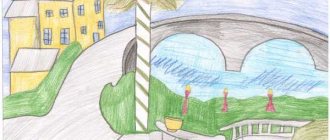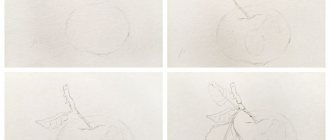Pointillism in painting: history of style and photography. Research work on the topic of pointillism technique
Pointillism is seen as part of the Post-Impressionism movement. The style was founded by artists Georges Seurat and Paul Signac. Unlike impressionism, pointillists used only dots of pure color to create images.
A cluster of dots made up a solid image. Pointillism is not only a direction of art and painting, it is a specific technique for painting. The peak of development of the direction is considered to be the 1880s - 90s.
Origin
Art historians believe that pointillism, as an art movement, was a product of neo-impressionism. The year of birth of the style is 1885, the country is France, where the founders of the movement studied and developed.
The most famous painting representing the style is “Sunday on an Island” by J. Seurat. it is a recognized masterpiece: the canvas is over 6 feet high and 10 feet wide. Seurat worked on it for about two years - painstaking work that required precise drawing of the small dots of different colors that made up the landscape. You can see the painting today at the Art Institute of Chicago.
Symbolism as a style in painting
Representatives of the direction
Signac not only became the heir to Seurat's style, but also an experimenter - he worked with the distance between points, studying the features of its influence on the perception of a mosaic image by the eye. On Seurat’s canvases the dots are located at the same distance, in Signac’s they move closer and further away from each other.
The result of the artist’s experiments is the creation of dynamic, three-dimensional images by drawing dots at different distances.
Other famous representatives of the style:
Vincent Van Gogh
Camille Pissarro
Style Features
Color theory
In creating the style, Seurat used the general principle of color theory - the human eye mixes the colors of points located nearby.
When depicting objects on the canvas, dots of contrasting shades are used - blue and orange, red and green, yellow and blue. Thanks to this technique, objects are expressive. Adjacent colors do not mix with each other.
The optical effect of the dots is designed for the color connections and transformations to be made by our eye.
The painting “Sunday on the Island of La Grande Jatte” by Seurat was a shock and the opening of the Impressionist exhibition in 1886. Thanks to the effect of color theory, the image turned out to be vibrant and multidimensional from a distance. If you come closer, the picture disintegrates into dots. The artist’s goal was achieved - he conveyed the vibrations of the air and the beauty of nature.
Works in the style of pointillism
Classic pointillism in painting is represented by the works of Georges Seurat: “Circus”, “Ships at Sea”, “Bathers in Asnieres” and Paul Signac: “Harbor in Marseille”, “Breakfast”, “Venice, Pink Cloud”. As well as experimental works by Van Gogh “The Sower and the Sunset”, A. Matisse “Parrot Tulips”, paintings by C. Pissarro “Hampton”, “Haymaking in Eragny”, “Children in the Manor Courtyard”. Today, works using this technique are masterpieces sought after by museums and collectors. After all, there are few such paintings, and they are real rarities.
Pointillism in painting: history of style and photos
In the 19th century, France was swept by a wave of innovative artists who rejected the old school of painting and sought new ways of creative expression. A breakthrough in this area was the formation of the impressionism style, which was fundamentally different from all the visual techniques that existed at that time. More and more artists joined the new movement and brought their ideas to it.
Meaning of the term
One of these ideas was experiments with color and an attempt to turn the process of creating an image on canvas into a scientific experiment. This is how a new direction in painting was formed - pointillism. The name is based on the characteristic manner of painting.
This new style was not elemental and spontaneous, like classical impressionism; the artist was clearly aware of what he was doing and what result he wanted to achieve.
The name comes from the French word pointel - dot writing, writing with dots. Another name less commonly used is divisionism, which means “division.” Pointillism in painting refers to the manner of painting by applying individual colorful dots at a certain distance from each other.
The emergence of style and color theory
The pointillism technique in painting is not just a chaotic application of colored dots. Each of them occupies its strictly defined place. For example, blue should be next to yellow, red should be next to green.
Because, according to color theory, from points of two different colors located next to each other, the human eye itself mixes a third color. Yellow and blue dots located nearby, mixed on the retina of the eye, will appear green to us.
The first person to put these features into practice was the French artist Georges-Pierre Seurat.
He became cramped within the framework of impressionism after he began to study the scientific research of Eugene Chevreul, Hermann Helmholtz, and Ogden Rood. In their scientific works they wrote about the perception of color by the retina, about light spectra, and about color formation.
Being under their influence, he decided to make a kind of revolution in fine art, based on the theory of color mixing.
Its essence is that there are three main adaptive colors - red, green and blue, by mixing which you can get any shade perceived by the human eye.
Pointillism in the painting of Georges Seurat
Through experiments, Sera came to the conclusion that the most convenient technique for realizing his ideas would be a point technique. He took basic pure colors and consistently filled the space of the canvas with neat dots, creating very specific images. The first successful experience that he presented to the general public was “Sunday Afternoon on the Island of La Grande Jatte.”
The picture made a very strong impression on the audience. At a close distance, they could only see a mosaic fabric woven from a thousand small dots.
But when they took a few steps away from the picture, a living and multifaceted scene appeared before them, in which the swaying of the air could clearly be discerned.
Moreover, the audience did not even suspect that the film used only three primary colors and two additional ones, not mixed with each other. Optical mixing of colors occurred directly on the retina of the eye when viewing the picture from a distance.
Seurat, unlike many artists, did not work plein air (outdoors), but in the studio, using photographs. This gave him many advantages.
He could take his time, carefully select colors and think through every stroke, and, importantly, he could not follow the changing lighting, not catch the right moment.
The artist lived a very short life, did not live to be 32 years old, but managed to introduce his own style of pointillism into painting and find like-minded people and followers.
“An animated point”: the “pointillism” technique in children's creativity
The once spontaneous passion for drawing gradually turned from a hobby into a professional activity. But it’s great when you do what you like, create, learn new things, communicate with like-minded people.
Fine art covers a very wide range of types, movements, trends. Pointillism, which I want to talk about today, is just one of them, it is a type of post-impressionism. I have prepared a book (manual) for publication, which I called “Living Dot”, it is intended for classes with children in this style and a similar graphic one - using one texture in drawing - a dot. Today I will briefly tell you how you can “revive” an ordinary point.
Children are initially talented, like nature itself, because the “works” of nature arise similarly to children’s drawings: as imprints of a spontaneous process that has no purpose.
Drawing for a child is part of his multilateral development. At all times, experts have attached great importance to children's drawings, because through drawings a child shows his dreams, perception of the world around him, and his mood.
Both teachers and doctors believe that drawing for children affects their development, having a positive effect on the central nervous system. Accordingly, drawing techniques for children are being developed.
In the practice of teachers working with children, non-traditional techniques occupy a large place, in particular, drawing with a fingerprint, palm print, blots, and impressions. They can be simplistically classified as drawing with a print, or simplified as a dot, only the dot is placed using different means (the accepted term is drawing with stamps, where in this case the role of a stamp is played by a palm, a blot, or crumpled paper). This will help explain the narrower and more complex movement of painting pointillism , the basics of which I propose to get acquainted with. Using excerpts from your book.
Drawing with dots with children can be done in monochrome (this will, in fact, be a graphic drawing using one texture - dots, which is now often also called pointillism, although this is not true and contradicts the very idea put forward by the founders of the movement). When performing paintings in the pointillism style with different colors of gouache, oil, acrylic and even watercolors, pure paints that do not mix on the palette are used: according to the theory of pointillism, mixing colors and obtaining the effect intended by the artist occurs when a person optically perceives an image from a long distance (this is especially true for large canvases).
For younger schoolchildren and primary school students, it is proposed to master the “pointillism” technique using materials that are not entirely traditional for it - colored markers (felt-tip pens). The proposed method of depicting dots using felt-tip pens allows not only to develop students’ fine motor skills, their perseverance, and perception of contrasts in a picture, but also to create an overall positive emotional background, since the image obtained using felt-tip pens (color markers) does not require drying, and paint bleeding is eliminated or their inaccurate mixing. These kinds of works can be done with children, using only one texture - a dot, one color, or making real picturesque paintings in a multi-color range, following or partially using the principles and ideas of pointillism.
Mastering the “pointillism” technique provides a wide opportunity to create real masterpieces of painting. It is precisely such works that are created by teachers when studying this topic within the framework of the School of Painting and Graphic Techniques, and then implemented in the classroom. Since the execution of any famous work of art in a different style allows such a work to be considered the author’s, you can try to reproduce a painting by a famous artist yourself. In this case, the main task - building a composition - has already been solved, all that remains is to transfer it and transform the image style, this is very important for a novice artist. In our classes we use artistic gouache. These are the wonderful works that come out (they are not completely completed, but nevertheless they give a complete idea of the technique). The result is different for everyone, even if only one sample was taken - but it comes from the individual vision, character traits, knowledge, skills and abilities, creative perception of each artist.
Landscapes depicting rounded shapes: clouds, forests, trees are good for using the pointillism technique.
Nowadays it is very fashionable to paint household items using the dot technique: bottles, plates, boxes and other household items. Such objects painted with acrylic and stained glass paints look very beautiful (point to point technique).
Pointillism: history of world art
The painting style that rocked the world of artists in the second half of the 19th century—neo-impressionism—in 1885 in France gave birth to a unique movement—pointillism. Critics spoke extremely unflatteringly about the technique, which eliminated the mixing of colors on the paintings. But pointillism found its fans.
Pointillism as a painting style
Pointillist paintings are easy to identify at first glance. They consist of individual point or rectangular strokes. The technique itself gets its name from the French word pointiller, meaning “to write with dots.”
Each point in pointillist paintings is located at a short distance from the others, and, therefore, its color does not mix with the color of the neighboring point. However, the work of connecting colors and turning individual dots into a single canvas is done by the human eye. This is what our eyes do every second when we look at something.
The pointillists did not pursue the idea of surprising anyone with an unusual and rather complex painting technique. They sought to convey in their works the movement of air and the energy of nature.
And they succeeded very well. However, there were critics who said that pointillism excludes creativity and turns painting into a tedious mechanical activity. But this is not true at all.
Georges Seurat and other pointillists
Fascinated by color theory, having studied the works of C. Blanc, O. Rude and E. Chevreul, the young artist Georges-Pierre Seurat decided to put his knowledge into practice, creating a canvas consisting of dots without mixing them.
According to color theory, the human eye mixes nearby points of different colors into one color. For example, yellow and blue dots standing next to each other will appear to a person as a green spot from a certain distance.
This can be seen in the example of the famous painting by J-P. Seurat's "Sunday Afternoon on the Island of La La Grande Jatte," which shocked critics at an exhibition of Impressionist works in 1886. The picture turned out incredibly alive, multidimensional.
Contrasting dots create the effect of oscillating air. Seurat achieved the desired effect - he managed to convey the beauty and naturalness of the light-air environment.
The idea of J-P. Seurat was supported by artists such as Paul Signac and Henri Cross. And even one of the founders of impressionism, Camille Pizarro, worked in the style of pointillism for 5 years.
Henri-Edmond Cross Beach on the Mediterranian 1891
Camille Pissarro Railroad to Dieppe 1886
Seurat's pointillism opened up many possibilities for experimentation. For example, Paul Signac experimented with the distance between points. If J-P. Seurat's strokes were approximately equal distances from each other, creating the effect of smooth movement, while in Signac's paintings the points either came closer or moved away from each other, thereby achieving the effect of energetic movement and volume of individual elements.
Paul Signac Houses in the Port, Saint-Tropez 1892





